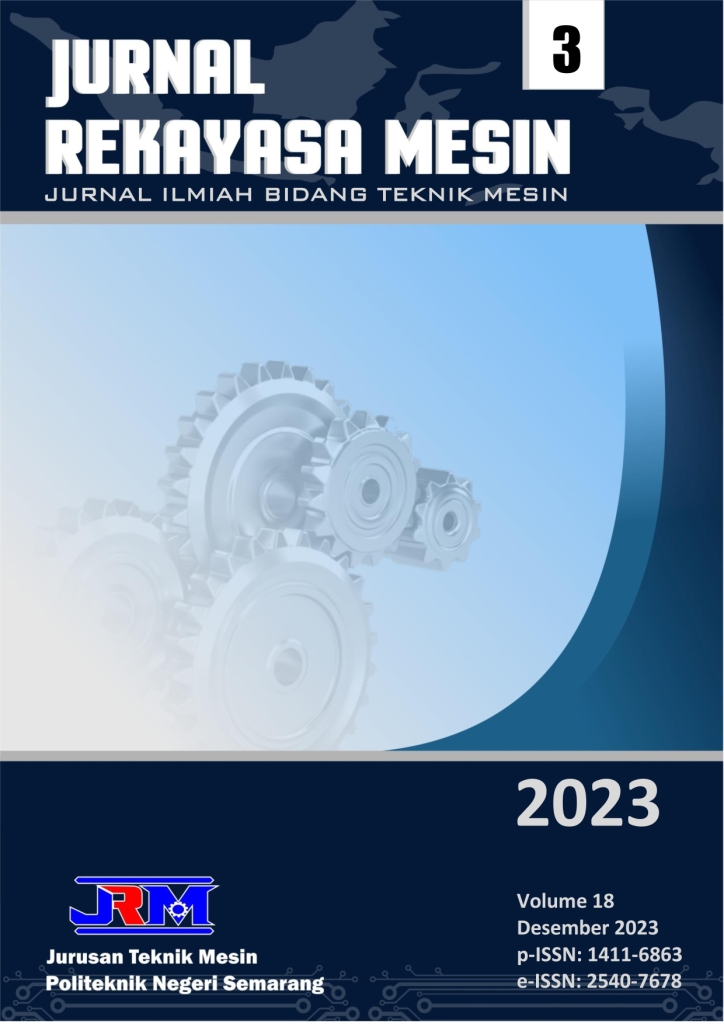Pengaruh Jenis Oli Pelumas terhadap Laju Keausan pada Kontak Dua Jenis Material
DOI:
https://doi.org/10.32497/jrm.v18i3.4438Keywords:
keausan, pelumas, sepeda motor, standard oli, tribo tester.Abstract
Penelitian ini dirancang untuk mengevaluasi kualitas oli pelumas sepeda motor dalam mengatasi gesekan dan keausan yang terjadi. Banyak merek dagang oli pelumas yang ada di pasaran dengan berbagai standard seperti SAE, JASO dan API yang bertujuan untuk melumasi bagian dalam mesin sepeda motor. Oleh sebab itu mengetahui kualitas oli pelumas yang digunakan adalah hal yang sangat penting. Penelitian ini menggunakan metode pin-on ring tribo tester. Efek dari pelumasan dan jumlah beban yang diberikan menjadi fokus dalam penelitian ini. Material yang digunakan dalam pengujian adalah aluminium sebagai bahan pin dan besi cor digunakan sebagai bahan ring. Sedangkan oli pelumas dari SAE10W40, SAE20W50 untuk gesekan tinggi dan SAE10W30, SAE20W40 untuk gesekan rendah. Prosedur pengujian dikondisikan pada constant load dan increment load dalam durasi waktu 120 menit. Hasil dari tribological test ini dibandingkan dengan stribeck curve dan keausan pin serta koefisien gesek ditampilkan dalam bentuk grafik.
Kata kunci: keausan; pelumas; sepeda motor; standard oli; tribo tester.
References
H. K. Trivedi and D. V. Bhatt, “Effect of lubricating oil on tribological behaviour in pin on disc test rig,” Tribol. Ind., vol. 39, no. 1, pp. 90”“99, 2017, doi: 10.24874/ti.2017.39.01.10.
S. Lee and M. Amarnath, “Experimental investigations to establish correlation between Stribeck curve , specific film thickness and statistical parameters of vibration and sound signals in a spur gear system,” no. June 2014, 2016, doi: 10.1177/1077546314544164.
P. Andersson, J. Tamminen, and C.-E. Sandström, “Piston ring tribology A literature survey,” 2002.
P. Olander, Tribology for Greener Combustion Engines. 2018. [Online]. Available: https://uu.diva-portal.org/smash/get/diva2:1161025/FULLTEXT01.pdf
V. W. Wong and S. C. Tung, “Overview of automotive engine friction and reduction trends ”“ Effects of surface , material , and lubricant-additive technologies,” vol. 4, no. 1, pp. 1”“28, 2016, doi: 10.1007/s40544-016-0107-9.
D. D. Mukherjee, “Multigrade Oil & Viscosity Index Improvers,” Leugner, L. Pract. Handb. Mach. Lubr. Maint. Technol. Int. Inc., Edmonton, Alberta, Canada Fitch, E. Proactive Maint. Mech. Syst. FES, Inc., Stillwater, no. 43, 2005.
K. Alhaifi, A. I. Abed, and N. Alhaifi, “Optimization of Different Grades Engine Oil Viscosity American Journal of Engineering Research,” no. 5, pp. 269”“273, 2017.
S. Number, “TECHNICAL BULLETIN,” no. February, 2015.
NewsRoom.AAA.com, AAA ENGIN OIL RESEARCH, no. May. 2017.
Jorn Larsen, Introduction to Friction. 1992. doi: 10.1007/978-0-387-92897-5_724.
V. Ojijo and E. R. Sadiku, “Improving wear resistance of polyolefins,” 2017. https://www.sciencedirect.com/topics/materials-science/tribological-process
V. L. Popov, Contact Machanics and Friction. 2010.
F.Al-Bender and K. De Moerlooze, “CHARACTERIZATION AND MODELING OF FRICTION AND WEAR : AN OVERVIEW,” pp. 19”“28, 2011.
M. S. Khan, Z. Hasan, and Y. A. Ansari, “Statistical Analysis for the Abrasive Wear Behavior of Al 6061,” J. Miner. Mater. Charact. Eng., vol. 02, no. 04, pp. 292”“299, 2014, doi: 10.4236/jmmce.2014.24034.
T. F. De Andrade, H. Wiebeck, and A. Sinatora, “Effect of surface finishing on friction and wear of Poly-Ether-Ether-Ketone (PEEK) under oil lubrication,” Polimeros, vol. 26, no. 4, pp. 336”“342, 2016, doi: 10.1590/0104-1428.2183.
M. A. Abdullah, S. A. Saleman, N. Tamaldin, and M. S. Suhaimi, “Reducing wear and friction by means of lubricants mixtures,” Procedia Eng., vol. 68, pp. 338”“344, 2013, doi: 10.1016/j.proeng.2013.12.189.
P. B. Warren, “Scaling theory for hydrodynamic lubrication, with application to non-Newtonian lubricants,” pp. 1”“6, 2015.
A. Samuel and J. Weir, Introduction to Engineering Design Special Acknowledgment Acknowledgment, no. November. Elsevier Science & Technology Books, 1999.
Downloads
Published
How to Cite
Issue
Section
License
Copyright of articles that appear in Jurnal Rekayasa Mesin belongs exclusively to Penerbit Jurusan Teknik Mesin Politeknik Negeri Semarang. This copyright covers the rights to reproduce the article, including reprints, electronic reproductions, or any other reproductions of similar nature.







